- Home
- Nicholson Baker
Double Fold Page 2
Double Fold Read online
Page 2
Can’t scientists foretell with a fair degree of certainty how long a newspaper collection of a given age will last? No, they can’t; there has never been a long-term study that attempted to plot an actual loss-of-strength curve for samples of naturally aging newsprint, or indeed for samples of any paper. Years ago, William K. Wilson,11 a paper scientist, began such a study at the National Bureau of Standards. For three decades he recorded the degradative changes undergone by a set of commercial book papers; then somebody decided to clean out the green filing cabinet in which the papers were stored—end of experiment. “That raised my blood pressure a little,” Wilson told me.
In the absence of real long-term data, predictions have relied on methodologically shaky “artificial aging” (or “accelerated aging”) experiments, in which you bake a paper sample in a laboratory oven for a week or two and then belabor it with standardized tests. With your test results in hand, you can, by applying a bit of chemist’s legerdemain called the Arrhenius equation, come up with what appears be a reasonable estimate of the number of years the sample will last at shirtsleeve temperatures. But the results of these sorts of divinatory calculations, invoked with head-shaking gravity by library administrators, have been uniformly wrong, and they are now viewed with skepticism12 by many paper scientists. The authors of the ASTM Standards, for example, write that the use of the Arrhenius equation to predict the life expectancy of paper is “an interesting academic exercise,13 but the uncertainty of extrapolation is too great for this approach to be taken very seriously”; William Wilson points out that you can’t predict how long an egg will last in the carton by putting it in boiling water for five minutes. Paper has a complex and as yet ill-charted chemistry, with many different molecular and mechanical processes under way concurrently; one Swedish researcher wrote that it is a “naive hope”14 to think that we can estimate “the life length of books by means of accelerated aging tests and [the] Arrhenius approach.”
In a way, however, all surviving newspaper collections, in and out of libraries, are taking part in an immense self-guided experiment in natural aging—an experiment that confutes the doctrine of newsprint’s imminent disintegration. Peter Waters, former head of the conservation lab at the Library of Congress, told me that he sees no reason why old ground-wood pulp paper can’t hold its textual freight for “a hell of a long time” if it is properly stored. He notes that most of the cellulose-sundering chemical reactions that can happen to a book or newspaper volume seem to take place in the first decade or so of its life; fifty years of handling paper (Waters is a master bookbinder) have taught him that the rate at which paper loses strength decreases significantly over time—the curve of observed decay levels out. There is a very good chance, then, that a volume of the New York World that is doing okay at age ninety will be in pretty much the same shape when it is a hundred and eighty, assuming someone is willing to take decent care of it.
The British Library’s papers had escaped the Blitz and the agenbite of their own acidity, but their keepers craved the space they occupied. English law requires that the library preserve British newspapers in the original but makes no such stipulation for foreign papers, and in 1996 the library quietly announced its intent to rid itself of about sixty thousand volumes—almost all the non-Commonwealth papers printed after 1850 for which they had bought microfilm copies. (The microfilm, much of it shot in the United States decades ago, is of varying quality—some good, some not good, all on high-contrast black-and-white stock, which wasn’t designed to reproduce the intermediate shades of photographs.) The announcement appeared as an inside article in the newspaper library’s newsletter;15 it was written up not long after as a short wire-service story16— “British Library Giving Away Historic Newspapers.”
In 1997 the library selected for discard17 more than seventy-five runs of Western European papers and periodicals, from France, Belgium, Germany, Austria, Greece, Italy, Portugal, Spain, the Netherlands, and Switzerland. They were able to place a number of these titles with national and university libraries; others they planned to sell or throw away. (I first found out about these developments in 1999; library officials still have not provided an accounting of where everything went.) Baylor University in Texas asked for, and got, eight runs of important French and Italian papers from the 1850s on, some of which will become part of their renowned Armstrong Browning collection, since Robert and Elizabeth Barrett Browning likely would have read those papers in their expatriate years.
Very few people knew any of this was going on. Although I interviewed a number of American newspaper librarians and dealers, I heard nothing of it; and even well-connected heads of libraries within England—such as David McKitterick, librarian of Trinity College, Cambridge, who serves on an advisory board of the British Library—were not informed of the “overseas disposals project,”18 and learned of it only late in 1999, when word began to get out. McKitterick objects to the “very quiet way” in which the deaccessioning was handled (at the very least, other British libraries should have had a better-advertised chance at the papers, he says), and he is troubled by what is on the lists; he mentions, for instance, the newspapers of pre-Revolutionary Russia, Nazi Germany, and occupied France. “I’ve now talked to a number of scholars about this,” McKitterick told me, “and they’re absolutely furious. When you replace a broadsheet newspaper with microfilm, you effectively kill stone dead much of what it meant at its time. Film can’t deal adequately with illustrations—and yet they were discarding the great French illustrated papers of the early twentieth century.”
But library administrators had other things to think about than illustration and scholarship. “Increasing pressure19 on the storage facilities at the Colindale site” was the justification for their desperate act. One of the finest libraries in the world was unable or unwilling to buy, build, retrofit, or lease a ten-thousand-square-foot warehouse anywhere in England that could hold their unique international collection.
With Western Europe taken care of, having freed up thousands of linear meters of shelf space without any political trouble, the British Library then moved on to papers from Eastern Europe, South America, and the U.S.A. They sent out notices of availability to the Library of Congress and the American Antiquarian Society, of Worcester, Massachusetts. The Library of Congress rejected everything, but the American Antiquarian Society, which owns a famous collection of early papers (bound in black with gold trim), took several titles, mainly covering the era of the Civil War and immediately afterward. “The redcoats are coming!” librarians there said, shelving the red-spined British volumes next to their black ones. Richard Bland College in Petersburg, Virginia, claimed several nineteenth-century runs. John Blair, head of the history department, says he would have taken more of the British Library’s collection if his college had had more space; Blair remembers working as a stock boy in a large Massachusetts library in the fifties and hauling home dozens of unwanted newspaper volumes. “They just junked them,” he said; he has used them for years in his classes. Blair likened the clearing out of newspaper collections to the overeager tearing up of track as the railroads went into decline. “Now maybe they regret losing some of those rights-of-way,” he said.
No other libraries expressed interest in the huge remaining mass of U.S. material. The plan, blessed by the British Library’s board, was to offer to dealers whatever libraries left unclaimed; anything dealers didn’t want was to be thrown away: “Material for which we cannot20 find a home will be offered to dealers for sale, or as a last resort sent for pulping.” Brian Lang, the director of the British Library, reiterated this plan in a letter to me: “The intention is that runs of newspapers for which no bids have been received will be pulped.”
CHAPTER 2
* * *
Original Keepsakes
I didn’t want the newspapers to be dispersed by dealers or “pulped” (awful word), so I hastily formed a non-profit corporation called the American Newspaper Repository, and, when it was clear that the a
uction was going to go forward whether I liked it or not, I submitted bids. A dealer from Williamsport, Pennsylvania, Timothy Hughes Rare and Early Newspapers, also bid on the papers, as it turned out. Hughes owns a medium-sized, pale blue warehouse, tidily kept, filled with rows of industrial shelving; on the shelves rest about eighteen thousand newspaper volumes. He is an undemonstrative man with a small mustache, honest in his business dealings, who was formerly on the board of the Little League Museum in South Williamsport. His usual practice is to “disbind” the newspapers—that is, cut them out of their chronological context with a utility knife (you can hear the binding strings pop softly as the blade travels down the inner gutter of the volume)—and sell the eye-catching headline issues (Al Capone, the Lusitania, Bonnie and Clyde, Amelia Earhart) or issues containing primordial Coke ads or Thomas Nast illustrations, shrink-wrapped against white cardboard, at paper shows (where buyers gather to look over vintage postcards, baseball cards, posters, and other ephemera) or through his printed catalog or website. His father, jolly and self-effacing, is a retired sharpener of band-saw blades, as was his grandfather; now his father and his brother, along with an amiable ex-schoolteacher named Marc, are employees of the company, filling orders, moving pallets of incoming volumes around with a forklift, writing catalog copy, and gradually working down the inventory, almost all of which came from libraries.
If American libraries had been doing the job we paid them to do, and innocently trusted that they were doing, over the past five decades—if they had been taking reasonable care of our communal newspaper collections rather than stacking them in all the wrong places, and finally selling them to book-breakers or dumping them in the trash outright (an employee of one Southern library recently rescued from a Dumpster, and successfully resold to a dealer, a run of Harper’s Weekly worth ten thousand dollars)—then the British Library’s decision to auction off millions of pages of urban life, although it would mark a low point of cultural husbandry, would not have been such a potentially disastrous loss to future historians. Fifty years ago, after all, there were bound sets, even double sets, of all the major metropolitan dailies safely stored in libraries around the United States.
But that is no longer true. The Library of Congress and the New York Public Library once owned Pulitzer’s New York World complete, for instance, and Harvard University, the University of Chicago, the Chicago Public Library, and the Chicago Tribune Company once owned sets of the Chicago Tribune. They don’t now. (“I’m sorry to say and appalled to say that they were tossed,” an employee of the reference department of the Chicago Tribune said to me. “It was before my time.”) At Columbia University (whose school of journalism Pulitzer founded), at the New York Public Library, and at the Library of Congress, you can flip through memoirs, biographies, scholarly studies, and original holograph letters of Joseph Pulitzer, works that describe his innovations in graphic design and recount his public squabble with Hearst over The Yellow Kid, a popular color cartoon that first appeared in the World in the 1890s—a squabble that begat the term “yellow journalism.” But the World itself, the half-million-page masterpiece in the service of which Pulitzer stormed and swore and finally went blind, was slapdashedly microfilmed in monochrome and thrown out by the New York Public Library, probably in the early fifties. Columbia said good-bye to its World at some point thereafter; the New-York Historical Society did so around 1990. The University of Chicago library, under the direction of micro-madman1 Herman Fussler (former lead librarian and information specialist for the Manhattan Project), produced a bad copy of the Chicago Tribune in the fifties as well. The Library of Congress was quick to clear its shelves of the World and most of the Chicago Tribune and replace them with copies of the NYPL’s and the University of Chicago’s microfilm; and copies of that very same mid-century microfilm—edge-blurred, dark, gappy, with text cut off of some pages, faded to the point of illegibility on others—will now have to serve for patrons of the British Library, too.
All the major newspaper repositories—the Center for Research Libraries in Chicago, for instance, and the State Historical Society of Wisconsin, both of which once had collections of national importance—have long since bet the farm on film and given away, sold, or thrown out most of their original volumes published after 1880 or so. Nearly all major university libraries, state libraries, and large public libraries have done the same. Even the great American Antiquarian Society, having decided some years ago to narrow its focus to publications before 1876, is arranging with Timothy Hughes to swap long runs of some small-town papers—the Fitchburg (Massachusetts) Sentinel from 1888 on, for example—for older titles that they want.
The Kansas State Historical Society, founded by a group of newspaper editors in 1875, had, until a few years ago, an unusually fine out-of-state newspaper assemblage, including a pre-Civil War file of the New York Tribune, a long run of the Boston Investigator, and a large number of otherwise impossible-to-find Western and territorial papers. Then the society put up a new building that was smaller than it should have been and, in 1997, had an auction. One observer told me that the lots that Kansas ended up selling were so unusual, so valuable, that a group of buyers got together ahead of time to divvy things up, so that the bidding wouldn’t go completely insane. It was “once-in-a-lifetime stuff,” this observer said. The next step, according to Patricia Michaelis, the director of the library and archives division, was to dispose of most of the society’s comprehensive collection of original Kansas papers printed after 1875, offering them first to institutions and then throwing out the leavings. Michaelis believes that the original papers are doomed anyway: “They’re just inherently going to crumble apart, no matter what you do to them, because of the acid content.” About half of the people who use the library come for the newspaper collection. Do they like the microfilm? Michaelis laughed. “Well, it’s the only option we give them.”
At another midwestern historical society, out in a pole barn, a collection was stacked twelve feet high and twenty feet wide near rows of shaft-drive bicycles and the disassembled pieces of a nineteenth-century machine shop. There were thousands of volumes of local papers and a run of The New York Times. Shawn Godwin,2 an employee of the society at the time, wrote me that this “cube of history” was made to disappear by order of the head archivist: the volumes were chainsawed in half and fed into the steam engine that powered a vintage sawmill exhibit. “I asked one of the more sympathetic assistant directors if it would be possible to sneak a few of the volumes away,” Godwin writes. “He indicated if I was discreet and did not make a big deal about it it might be okay.” Godwin saved a small stack and tried to avoid looking at the column of smoke rising from the sawmill.
The cleanout continues. Since the mid-eighties, the vast U.S. Newspaper Program,3 a government project whose aims are to catalog as many newspapers in the country as possible (a worthy goal) and to microfilm those local papers that were passed over in earlier decades, has given libraries about forty-five million dollars in so-called preservation money—and zero dollars for storage space. The National Endowment for the Humanities, which pays for the U.S. Newspaper Program (and funds a related enterprise, the Brittle Books Program), makes no requirement that libraries actually preserve, in the physical sense of “reshelve,” their originals after they have been sent out for federally funded filming. The effect of all this NEH microfilm money has been to trigger a last huge surge of discarding, as libraries use federal preservation grants to solve their local space problems. Not since the monk-harassments of sixteenth-century England has a government tolerated, indeed stimulated, the methodical eradication of so much primary-source material.
Surely this material is all available on the Web by now, or will be soon? In time, eighty or a hundred years of a great urban paper could well become the source for a historical database of richness and utility. But at the moment, the scanning and storing and indexing of hundreds of thousands of pages of tiny type, along with halftone photos and color illustrations, would
be a fearsomely expensive job; and even if money were limitless, there would remain the formidable technical challenge of achieving acceptable levels of resolution using digital cameras for formats as large as those of a newspaper spread. Nor will high-quality digital facsimiles of our major papers ever exist unless we decide right now to do a much better job of holding on to the originals—even the mangy ones with crumbly edges. You can’t digitize something that has been sold off piecemeal or thrown away, after all; and attempts to scan the page-images of newspapers from old microfilm have not worked well—and will never work well—because the microfilm itself is often at the squint-to-make-it-out level. HarpWeek, a venture that offers a digital copy of Harper’s Weekly on the Web, spent tens of thousands of dollars trying to scan the available microfilm, but they found that thirty percent of the resultant images were bad. Now they’re working from two original sets of the journal, both of which they’ve cut out of their bindings in order to set the loose pages flat on the scanner.

 House of Holes
House of Holes Checkpoint
Checkpoint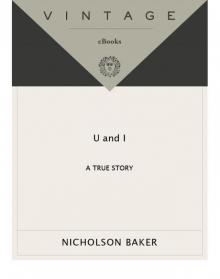 U and I
U and I The Fermata
The Fermata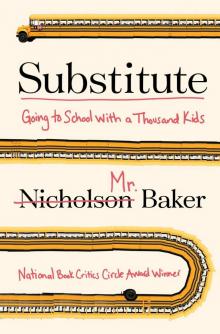 Substitute
Substitute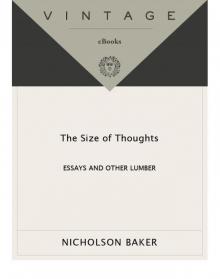 The Size of Thoughts
The Size of Thoughts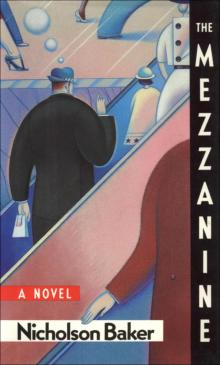 Mezzanine
Mezzanine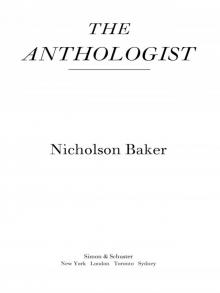 The Anthologist
The Anthologist Traveling Sprinkler
Traveling Sprinkler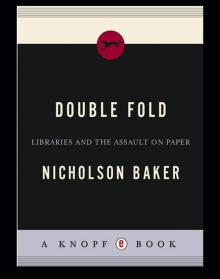 Double Fold
Double Fold The Everlasting Story of Nory
The Everlasting Story of Nory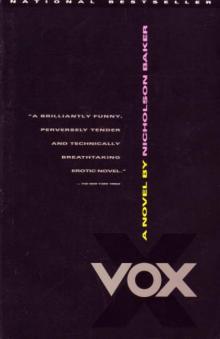 Vox
Vox Vintage Baker
Vintage Baker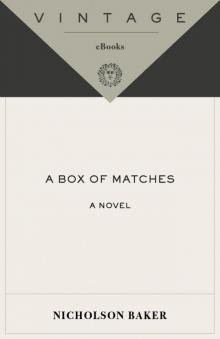 A Box of Matches
A Box of Matches